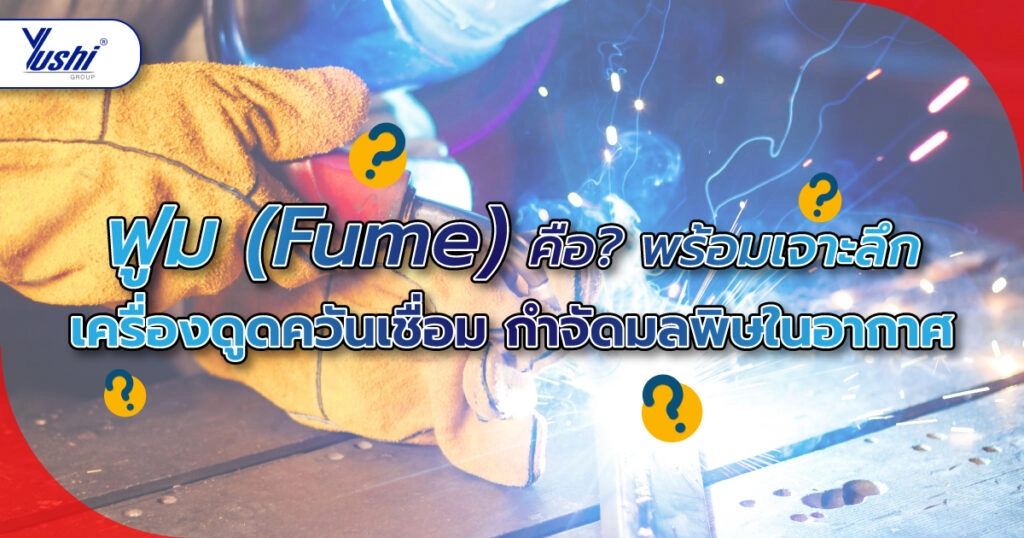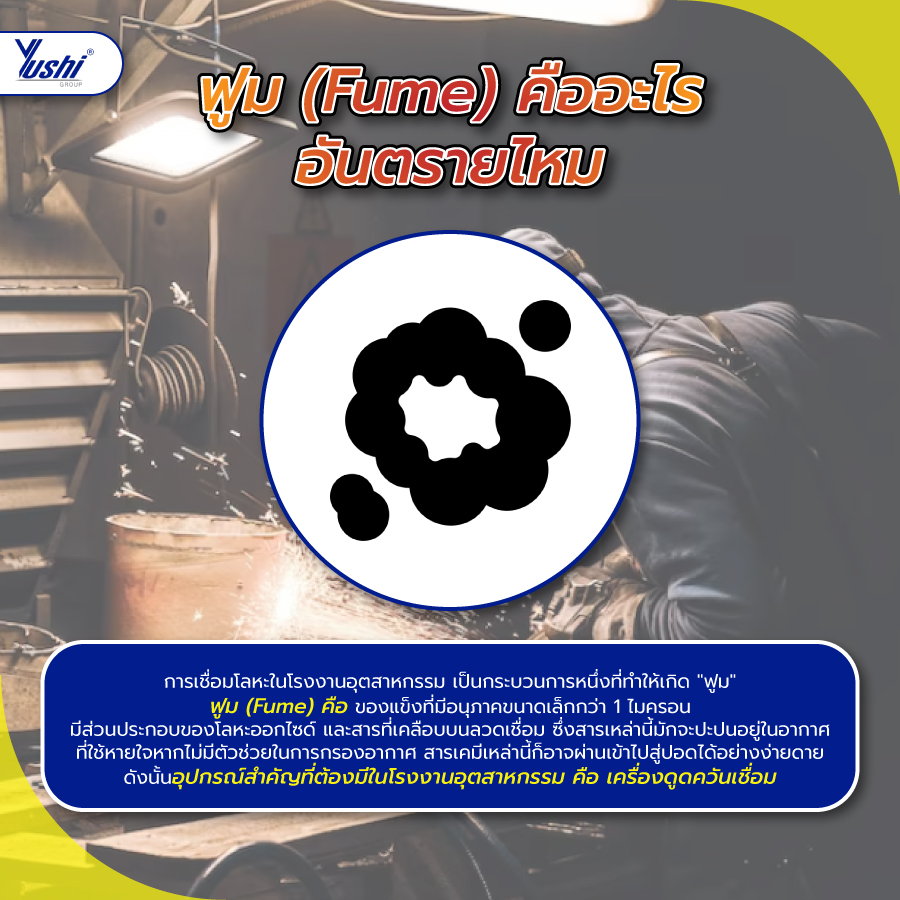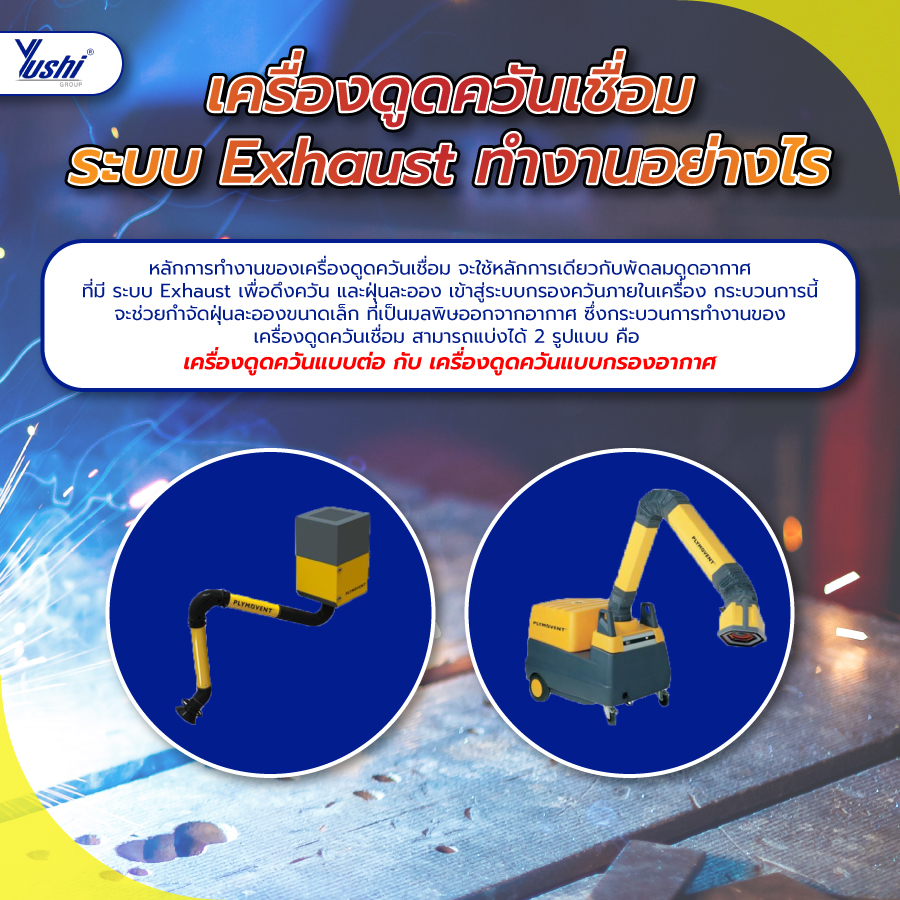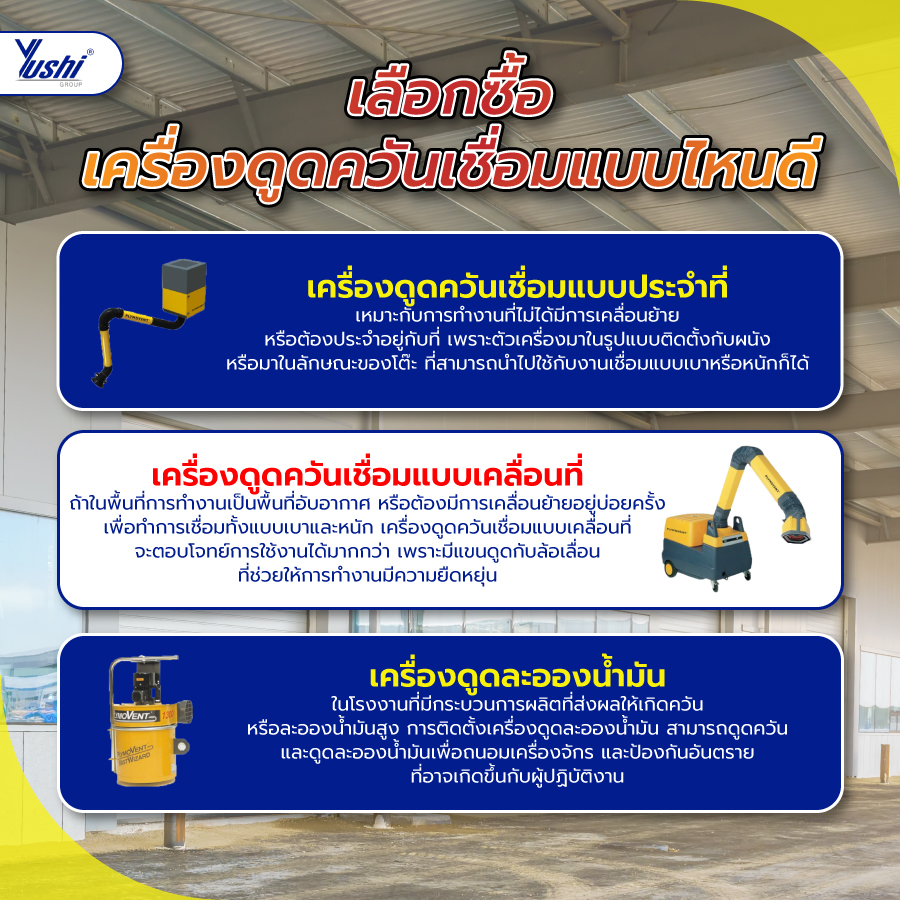"Fume" is? Along with an in-depth look, welding fume extractor that removes pollutants from the air.

During the welding process, operators are exposed to heat, UV light, sparks, gas fumes, and welding fumes regularly. All of these factors can have significant health impacts. Many factories choose to install welding fume extractors because they have exhaust systems that help remove pollutants from the air.
While many people may have heard of "welding fumes," some may not be familiar with the term "fume." In this article, Yushi Group will explain the meanings of these terms and provide insight into how welding fume extractors work to eliminate airborne pollutants deeply.
What is "Fume" Is it Dangerous?

Welding metal in industrial factories is one process that generates "fumes." First, let's understand the meaning of these terms. "Fume" refers to solid particles smaller than 1 micron in a gaseous state. These particles are mainly formed by the condensation of vapor from some chemical reactions and can remain suspended in the air for a long time.
Examples of fumes commonly found in workplaces include aluminum, lead, beryllium, cadmium, chromium, iron, copper, magnesium, nickel, and zinc, among others. If the concentration of fumes in the workplace is high, the rate of air exchange should also be high. Additionally, during metal welding, other hazardous gases may be produced, such as:
- Nitrogen dioxide, which occurs during welding. Exposure to this gas can cause irritation to the eyes, nose, and throat or even lead to unconsciousness if inhaled.
- Ozone gas, which is produced by ultraviolet radiation reacting with oxygen, often during steel and stainless-steel welding. Exposure to ozone gas can cause eye irritation and may lead to conditions like pulmonary edema or chronic respiratory issues.
- Carbon monoxide, which is produced when using carbon dioxide gas for welding. Excessive exposure to this gas can cause dizziness, headaches, loss of consciousness, and even death due to oxygen deprivation.
Chemical analysis of fumes reveals components of metal oxides and substances used to coat welding electrodes. These chemicals are often present in the air and can easily enter the lungs if there is no air filtration system in place. Therefore, an essential piece of equipment in industrial factories is a welding fume extractor. If you want to know how a welding fume extractor works, let's explore that in the next topic!

How Welding Fume Extractors with Exhaust Systems Work
Fumes generated from metal welding in industrial factories are unavoidable in the production process. However, we can mitigate these fumes and vapors by installing welding fume extractors. The working principle of these extractors is developed to filter welding fumes and vapors in welding, cutting, grinding, spraying, and polishing operations.
The working principle of welding fume extractors is similar to that of air fans with exhaust systems, which pull the fumes and dust particles into the filtration system. This process helps remove fine particulate matter from the air, which is hazardous to health. Welding fume extractors can be categorized into two main types: direct extraction systems and air filtration systems.
While these two types of welding fume extractors have different characteristics, they serve the same main purpose: removing fumes and filtering pollutants from the air effectively. Additionally, welding fume extractors facilitate air circulation within the workspace, helping to reduce heat generated from welding activities.

Methods of Welding Fume and Oil Mist Extraction:
- Direct extraction at the welding torch: Installing extraction equipment directly at the welding torch allows easy access to the equipment and enables the adjustment of the torch to the appropriate position, ensuring efficient fume extraction.
- Extraction with flexible arms: Installation of flexible arm extraction units allows for customizable positioning according to the specific requirements. These units are directly connected to the air filtration system, enabling the removal of a significant amount of contaminants.
- Portable welding fume extractors/filtration units: For factories with multiple welding stations, portable welding fume extractors offer versatility as they can be easily moved to different areas within the facility.
- Welding and grinding workbenches: Workbenches equipped with built-in fume and dust extraction systems can effectively remove welding fumes, dust, and small particles, making them suitable for stationary work areas.
- Robotic welding fume extraction: There are two options for robotic welding fume extraction: extraction units installed directly on the welding torch or hoods installed above the robotic system. Both solutions offer excellent extraction rates, depending on the user's requirements.

Which Welding Fume Extractor Should You Choose?
When selecting a welding fume extractor, it's essential to consider the purpose for which it will be used. Determine whether you need to eliminate toxic gases, general welding fumes, or fumes that may catch fire because different types of welding fume extractors have different functionalities. If the product is labeled "Remove The Fume," it's not suitable for extracting fumes that may catch fire, as it could pose a danger to the user. Welding fume extractors can be categorized into three types:
- Stationary welding fume extractors are suitable for stationary work areas or where constant presence is required. These units are typically installed on walls or in the form of tables and can be used for light or heavy-duty welding.
- Mobile welding fume extractors are ideal for poorly ventilated workspaces or where frequent movement is necessary for both light and heavy-duty welding. These units feature flexible extraction arms and caster wheels, providing greater flexibility in operation.
- Oil mist extractors are suitable for factories with processes that produce high levels of smoke or oil mist. Installing oil mist extractors helps preserve machinery and protect workers from potential hazards.
When choosing a welding fume extractor, various factors such as the workspace, nature of work, and installation area size should be taken into account to ensure that you select a suitable extractor that efficiently removes dust particles and fumes from welding.
Look for standard welding fume extractors with multiple options available at Yushi Group. We specialize in supplying, designing, and installing products related to welding fume extraction to improve factory environments and eliminate hazardous pollutants. Our industrial welding fume extractors come in various types, including stationary, mobile, and oil mist extractors.
If you're interested, our team is ready to provide on-site assessments to ensure proper installation according to standards and user safety. Additionally, we offer excellent after-sales service, with spare parts available for any potential issues, allowing you to use our welding fume extractors to their full potential.
For inquiries about products and services, feel free to contact us here.
Facebook: สินค้าอุตสาหกรรม เครื่องจักร งานติดตั้งระบบ Evap,Ventilation-Yushi Group
Line@: Yushi Group
YouTube: Yushi Group
E-mail: info@yushi.co.th
Tel: 02-517-0688






 Facebook
Facebook Line
Line YouTube
YouTube Shopee
Shopee